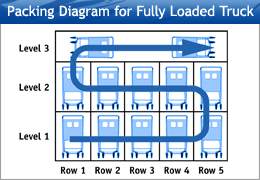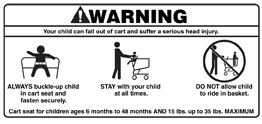Shopping Cart Safe Use & Maintenance Guide
In purchasing these carts, you have made a valuable investment. The information presented in this document will help you care for your carts. This will extend their useful life and reduce the fill-in rate for your fleet. Furthermore, keeping your carts in tip-top shape will help provide safe and usable shopping carts and add to the positive reception by your patrons.
It is the Owner/User’s responsibility to maintain and operate shopping carts consistent with these safety and maintenance recommendations, per the voluntary ASTM standard F2372-04.
Any shopping cart, no matter how well constructed, may fail in use as a result of mistreatment, improper maintenance or abuse. To reduce the risk, we strongly recommend you read and follow all safety and maintenance information contained in this document and implement your own safety inspection and maintenance program before placing your carts in service.
Packaging Information
 The diagram shown to the right describes how the carts on your order are packaged in the truck.
The diagram shown to the right describes how the carts on your order are packaged in the truck.
Depending on the size of cart you ordered, there will be one to five rows of carts across the truck.
Depending on the quantity of carts you ordered, there will be one to three levels of carts. If there is a third level,the carts will be laid on their side on the third level.
Your shopping carts have been built and inspected to operate safely upon proper receipt and unloading.
They have been counted and packed to assure you receive the correct delivery.
Receiving & Unloading Your Carts
- Immediately take control of the delivery. Your driver may or may not have previous experience unloading shopping carts.
- Once the trailer is backed into the loading dock check the bindings and study the packing diagram that identifies how your delivery was loaded. Important: ALWAYS unload carts from the top down. Unload each level SUFFICIENTLY before proceeding to the next level.
- DO NOT drop the carts to the ground when unloading. Note: Damage caused by improper unloading of carts is not covered by the Warranty.
- Count the carts as they are unloaded and contain them sothe cart count can be verified in case of a discrepancy.
- Inspect each cart for any damage during shipment. Identify any damage and the cart count on the Bill of lading, just as with any other shipment. IMPORTANT: Any damaged cart must be taken out of service immediately until repairs can be made.
- Missing or damaged carts must be reported within 48 hours of delivery. Call 1-877-894-4634 and speak to a customer service representative with the details of your shipment.
Safe Use Information
 The intended use of a shopping cart is to transport purchased goods. Any use other than what the cart is intended for can cause damage to the cart and make it unsafe.
The intended use of a shopping cart is to transport purchased goods. Any use other than what the cart is intended for can cause damage to the cart and make it unsafe.
Carts with damage, defects or missing parts must be taken out of service immediately until a repair or replacement can be made.
Each shopping cart has been provided with the safety-warning message pictured below, located on the child seating area. Children should only be allowed to sit in the child seating area of the cart and must be secured at all times with the seat belt.
The recommended child occupant age and weight requirements for shopping carts are children who are at least six months of age and at least 15 lb (7 kg) up to children who are not more than four years of age and who weigh no more than 35 lb (16 kg).
Safety Do’s and Don’ts
- DO educate your employees when and how to intervene when they observe unsafe use of carts.
- DO encourage shoppers to use the seat belt properly when they have a child in the cart.
- DO inspect carts daily for damage, defects, or missing parts and remove them from service immediately.
- DO maintain and repair your carts periodically to ensure they are in proper working order.
- DO inform management of unsafe conditions in the store, parking lot or on the property.
- DON’T allow shoppers to leave child(ren) unattended inshopping cart.
- DON’T allow children to ride on cart other than in the designated seating area.
- DON’T allow children to climb in and out of a shopping cart.
- DON’T allow children to push a shopping cart with a child in the seating area.
- DON’T overload the cart beyond its capacity or use it for something other than what it is intended.
Be Proactive in Promoting Safety In the Store
When it comes to in-store child safety, one of the single most important practices a retailer should undertake, in conjunction with providing safe shopping carts, is to alert parents and make them aware of the potential dangers associated with shopping carts when not used properly. There are a wide range of pre-printed, in-store signs and employee training materials to help aid retailers in creating a safer shopping environment for parents, children and themselves. Parents have come to depend on “rules” for children when in public places to reinforce their safe behavior. And, for the parent who is not aware of the dangers associated with shopping carts, in-store prompts can be an effective way to educate them and remind them of their responsibility, too. Call our Customer Service Department if you have questions or would like to get more information about in-store safety signage.
Safety Inspection Information
Inspecting your shopping cart equipment is necessary to keep it in proper working order. To assist in your Safety Inspection Program for your shopping carts we are providing the following Safety Inspection Checklist.
Carts should be visually inspected on a daily basis to identify problems. Have your staff familiarize themselves with the carts and what to inspect daily.
SAFETY INSPECTION CHECKLIST
If, upon inspection of a shopping cart, one or more of the following criteria fails – REMOVE THAT CART FROM SERVICE IMMEDIATELY UNTIL A REPAIR OR REPLACEMENT CAN BE MADE. Carts that have been removed from the fleet for repair should be tied together with a lock and chain and labeled “DO NOT USE – UNSAFE” until they can be repaired or replaced.
- Safety-Warning Label in child seat area is present and fully legible.
- Seat belt is installed correctly on the cart and is in working order. The buckle or closure can be opened and closed properly and the belt can be adjusted.
- There are no missing or broken components on the cart and all fasteners are tight and secure.
- Wheels and casters are not bent, loose or missing from their mountings and the wheels roll freely.
- There are no bent, cracked or protruding areas on the cart that may cause injury.
- All welds and/or joints are intact and the cart is level to the ground.
OTHER SAFETY ITEMS
Inform management of unsafe conditions in the store, parking lot or on the property.
If using in-store safety prompts to promote safe use of your shopping carts, make sure all posted safety information is present and legible.
If returning carts from the parking lot or moving them manually always limit the number of carts to 10 to prevent personal injury and damage to the carts. Never tie the carts to each other with the seat belt, this can damage the seat belt and make it unsafe for the user. Never pick up a row of carts from the rear or slide them sideways. This can damage the casters and/or the frame so that cart will have to be removed from service.
If using a cart pusher always limit the number of carts to 20 per trip. This helps to reduce excessive wear on casters and fatigue on the cart. Pushing more than 20 carts at one time can cause premature failure to the cart. Never run the line of carts into a curb or wall. This can damage the casters and/or the frame so that cart will have to be removed from service.
Care and Maintenance Information
Shopping carts routinely work day-in and day-out and flawless performance is expected. Individual circumstances vary, but the performance and life cycle is in your hands and requires ongoing care and attention. The following information is recommendations for maintenance of your carts that will help ensure a longer life. We strongly encourage that you clean and perform maintenance on your carts every 3 to 6 months. The carts should be serviced by trained in-house personnel or a qualified outside service company.
Clean Carts Every 3 to 6 Months
- Carts exposed to snow, ice and salt will need to be cleaned more often.
- Take carts out of the store and into a secured area away from cars and shoppers when cleaning.
- When using a power washer do not exceed 1500 psi of water pressure or 150 degrees F. of water temperature. Exceeding pressure and temperature limits may damage the metal coatings.
- Remember to check with your local state regulations regarding runoff of detergents or cleaners.
- Allow carts to air-dry before returning them to the store.
- Never use a solvent or a degreaser on the bearings of your carts. This will work only temporarily to stop any noise and will ultimately make the problem worse. For proper lubrication use only a caster-manufacturer – recommended oil or grease.
- Move carts prior to performing any nearby building maintenance such as cleaning to avoid getting chemicals on the cart finish.
Replace Worn Components
- Parts such as seat belts, casters, seat flaps and hand-grips can be replaced easily. Other cart repairs require a higher level of mechanical expertise.
- When replacing worn or missing seat belts it is important to note that the attachment of the seat belt is critical for its correct performance. Please refer to the instructions included with your replacement seat belts to ensure proper installation.
Important Storage Precautions
To reduce risk of personal injury and/or property damage:
- REMOVE paper and other flammable debris before storing carts
- NEVER store carts under a building structure without fire sprinklers; and
- ALWAYS store carts in a supervised or secured area to prevent vandalism.
If exposed to open flame or extreme heat, debris can ignite and
burn components and coatings of this cart, producing dangerous
gases and smoke. Fire can spread quickly, resulting in serious
injuries and property damage.
Store Carts in a Covered and Well Ventilated Area
- Do not store carts under a tarp. This traps moisture around the carts and will damage the carts’ metal finish.
- Avoid storing carts in standing water or near a water source that constantly drips on them.
- Rotate inside fleet with outside fleet. This allows carts to dry out from time to time during inclement weather.
- Do not allow carts to contact the exterior wall of the store. The aggregate surface can abrade through the metal finish causing corrosion problems.